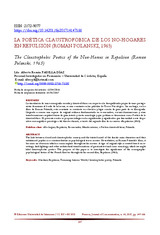La poética claustrofóbica de los no-hogares en Repulsión (Roman Polanski, 1965)
The Claustrophobic Poetics of the Non-Homes in Repulsion (Roman Polanski, 1965)
Autor
Padilla Díaz, Alberto Román
Editor
Universidad de SalamancaFecha
2017Materia
«No-hogar»Repulsión (1965)
Re-encuadre
Mundo interior
Poética claustrofóbica
Polanski, Roman, 1933-
METS:
Mostrar el registro METSPREMIS:
Mostrar el registro PREMISMetadatos
Mostrar el registro completo del ítemResumen
La vinculación de una escenografía cerrada y claustrofóbica con respecto a la desequilibrada psique de unas protagonistas
femeninas al borde de la locura, es una constante en las películas de Terror Psicológico. Sin embargo, en los
films de Roman Polanski, esta constante se convierte en obsesión y lugar común de gran parte de su filmografía.
Llegando a crearse una especie de original estilema fundamentado en re-encuadres, oscuras iluminaciones y otras
transformaciones arquitectónicas de gran interés y cierta semiología y que podríamos denominar como Poética de lo
claustrofóbico. El presente escrito se propone indagar en los significantes y significados que dan unidad a este dispositivo
escenográfico-psicológico del director francés, a través del segundo film de su carrera: «Repulsión» (1965). The link between closed and claustrophobic scenery and the twisted mind of the female main characters and their
unbalanced psyches is a constant feature in psychological terror movies. Nevertheless, in Roman Polanski’s films, it
becomes an obsession which is commonplace throughout his movies. A type of original style is created based on resettings,
dark lightings and other architectural transformations of great interest and some semiology, which we might
label claustrophobic poetics. The purpose of this paper is to investigate the significance of the scenographicpsychological
device of the French director throughout his second film, Repulsion (1965).

